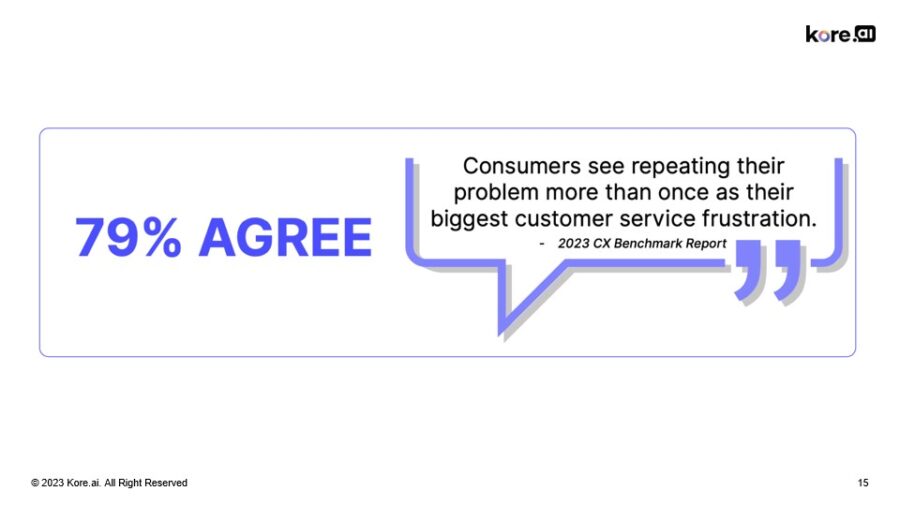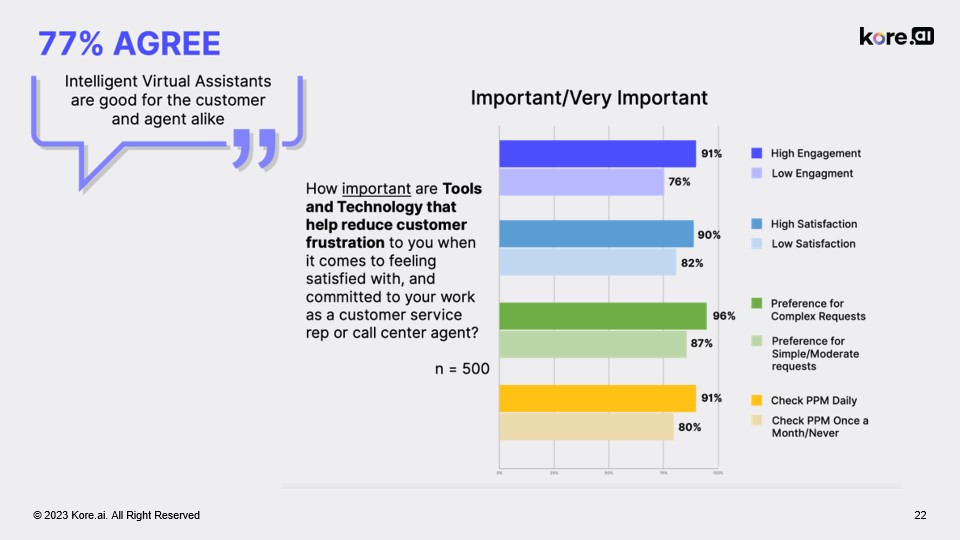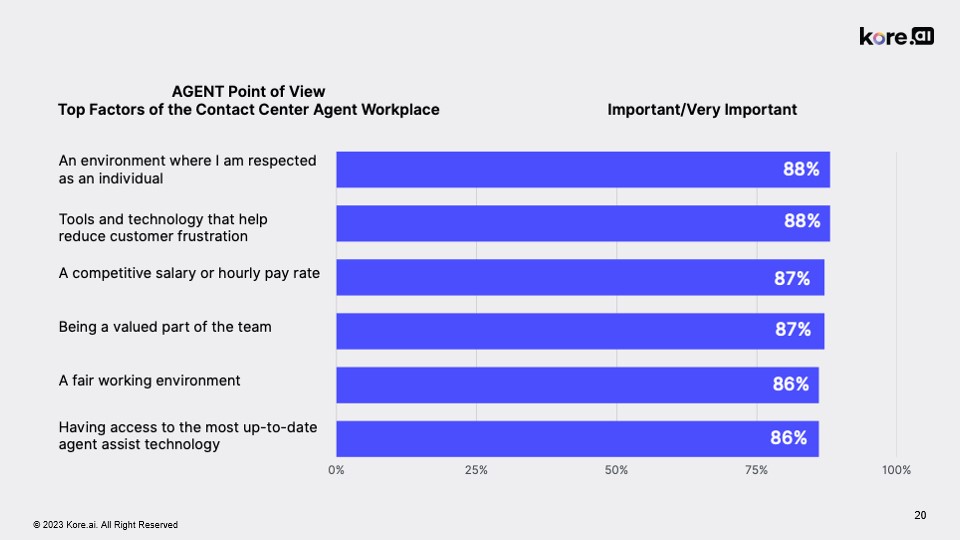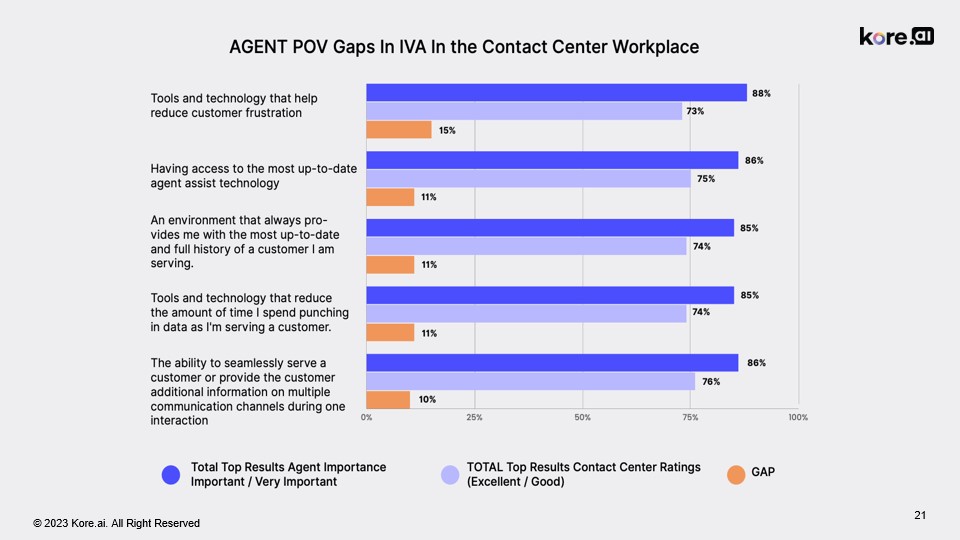I recently had the pleasure of running a webinar with Michael Kropidlowski, Kore.ai and Mike Farrell, Farrell Insights. In the webinar, we reviewed two new pieces of research. The first looked at customer expectations surrounding automated AI service delivery, and enterprise customer experience in general. The second looked at contact centre agent perspectives, looking at their current challenges, views on how their organisations are supporting their ability to deliver effective customer experience, and opinions on the potential of AI-mediated services. The results show some interesting learnings for contact centre and CX leaders about what customers and agents are telling you to do to enable great experiences for both.
The stand out stat from the customer survey was related to customer expectations of AI assistants, compared to their expectations of human agents.
When asked the question “How do you expect IVAs (Intelligent Virtual Assistants) and live agents to perform when it comes to customer service?” 70% of customers expect high performance from IVAs, and 77% expect high performance from live agents.

When asked the question “How do you expect IVAs (Intelligent Virtual Assistants) and live agents to perform when it comes to customer service?” 70% of customers expect high performance from IVAs, and 77% expect high performance from live agents.
These numbers are crazily close together. We ran a poll in the webinar to see what attendees thought of this and, like me, most people had the assumption that customers would have low expectations of IVAs in general, let alone being so close to human agents.
So what’s happening here? Has the ‘Alexa effect’ raised people’s expectations? This is the thing I’ve been banging on about for 5 years, that the more people interact with natural language-based technologies, the higher their expectations become. Perhaps it’s now the GPT effect?
Regardless, what’s clear from this research is that, if you’re considering launching an intelligent virtual assistant, an AI-mediated, automated agent, then according to this research, people have high expectations of its abilities. This raises the importance of making sure that you focus on a) making sure it’s able to deliver what the customer needs and b) that you design a great experience. I always recall Ben Sauer sharing with me on the VUX World podcast many moons ago, the two things that are critical in design strategy: designing the right thing, and designing the thing right. This research adds weight to that argument in the context of CX automation.
The second thing that stood out to me is that 79% of people agreed that repeating their problem more than once is the greatest source of frustration in customer service.

In The Effortless Experience, by Matt Dixson, Nick Toman and Rick Delisi, repeating information was found to be one of the biggest detractors of loyalty in customer service. 10 years later, it seems the problem hasn’t been solved and is still a thorn in the side of consumers.
The big lesson for CX leaders here is obvious: if you have any kind of AI agent in play, make sure that, when you hand off to a human agent, you provide the agent with everything they need to continue the conversation from where the AI agent left off.
From the agent experience study, perhaps the stand out stat for me was related to agent’s perspectives on AI automation. You’d think that contact centre agents would be concerned about the AI movement. With all the headlines around job losses, they surely should be the one group of people with the greatest concerns?
However, the research shows that 77% of contact centre workers agree that IVAs are good for both the customer, and for them.

The point here is that contact centre leaders shouldn’t be looking to AI to replace people. They should be looking at it as a way to give their people the tools they need to do the job they’re tasked with, and to help customers directly in the process.
Another stand out thing for me was that customer service agents value having access to tools and technology that help reduce customer frustration just as much as they value competitive pay and a positive work environment.

At the same time, when asked how agents would rate their current contact centre in its provision of those things, there’s a gap. Current contact centres aren’t all providing agents with the tools they need.
The distribution of workers in the contact centre has shifted, and a large proportion of workers are Gen X and Millennials. People who’ve grown up with the internet and either don’t know a time, or can’t remember a time, without iPhones, social media and on-demand information.
Yet, these people are thrown into the workplace and they’re tasked with swivelling between screens, systems and processes that don’t enable them to do the thing they’re there to do. When you’re used to having the answer to every question imaginable at the tip of your fingers, not having the same capability in the workplace leads to frustration, disappointment and, ultimately, poor customer experience.

The key takeaway for CX leaders here is to make sure that you’re focusing your efforts on giving your agents the right tools they need to do their jobs effectively.
There’s far more detail in the reports, and in the webinar, than I could ever hope to cover here. So if you’re interested in diving deeper, you can watch the replay of the webinar here, or download the CX benchmark and the AX benchmark directly.

